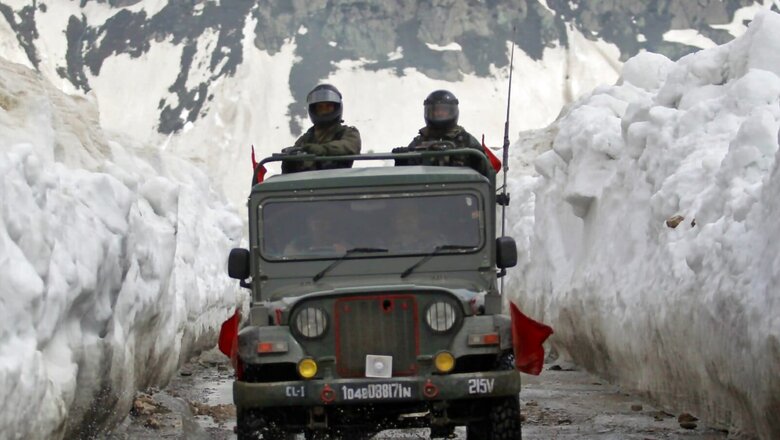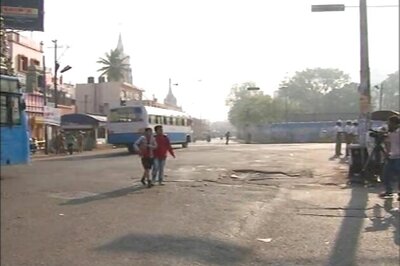
views
Thousands of Indian troops deployed at the icy heights along the Line of Actual Control (LAC) are bracing for a second consecutive winter in the harsh terrain amid tense ties with neighbouring China.
Ahead of the long, cold haul, the troops have been equipped with the latest Finnish Sako sniper rifles, Israeli Negev Light Machine Guns, the American Sig Sauer assault rifles, as well as a variety of contemporary drones along with the indigenous K9 Vajra T guns and the M777 Ultra-Light Howitzers (ULH).
Senior defence officials told News18.com that a massive logistical exercise is underway to provide the troops deployed at the LAC with tonnes of special rations and kilolitres of kerosene oil and special fuel oil, along with fresh habitat and additional sets of clothing suited to the extreme altitude and dipping temperatures over the next few months.
India has also significantly ramped up infrastructure at the LAC, particularly in eastern Ladakh, with the construction of temporary shelters, roads and bridges for faster mobility of troops when needed. The Indo-Tibetan Border Police (ITBP) has increased the number of warehouses in the Ladakh region to store larger quantities of ration. The paramilitary force has supplied food and ration to its troops much earlier this year, in the backdrop of the border tensions.
Deadlocked
With India and China failing to reach consensus over further disengagement along the LAC in the 13th round of military talks last week, India is preparing for the long haul in the region. Both countries have been locked in a military standoff at the LAC in eastern Ladakh since May last year.
There were hopes that the latest talks between India and China would lead to further disengagement of troops at least at Patrolling Point 15 (PP15) in the larger Hot Springs area, even as any such development at Depsang Plains is expected to take a longer time. China has been blocking Indian patrols at the Y-Junction and access to PP10 to PP12.
But with talks deadlocked, Indian troops will continue holding the newly-created posts at extreme altitudes along the LAC that were unoccupied prior to the Galwan Valley clashes in June 2020.
The stalemate came a week after a face-off between Indian and Chinese troops in the Tawang sector in Arunachal Pradesh. As reported by News18.com first, a strong Chinese patrol had transgressed the LAC and attempted to damage some Indian unoccupied bunkers.
ALSO READ | India Foils Chinese Incursion in Arunachal Pradesh, Briefly Detains PLA Troops
A similar activity at Uttarakhand’s Barahoti a month ago reflects China’s intent to expand the scope of transgressions along the 3,488-km LAC.
The long haul
While a regiment of the K9 Vajra T Guns has been deployed in high-altitude locations of eastern Ladakh, at least three regiments of M777 ULH have been inducted at various locations along the LAC. A fourth ULH regiment is likely to be raised by the end of this year.
The frontline troops have already been provided with the American Sig Sauer assault rifles, more than 72,000 of which were ordered in two batches each, and the Israeli Negev Light Machine Guns, 16,000 of which were ordered by the Indian Army in 2019. The deliveries for a dozen fast patrol boats and 17 special troop-carrying boats for eastern Ladakh have also begun.
Additionally, troops have also been equipped with a variety of specialised drones to undertake surveillance and reconnaissance missions. As reported by News18.com, four new Israeli Herons are likely to be delivered by the end of this year and will be deployed at the LAC.
India is also procuring a large number of counter drone systems, many of which would be deployed at the LAC. Additionally, the IAF has operationalised its second Rafale squadron at Hasimara in July this year.
More Troops, Restructuring Formations
With gradual disengagement in eastern Ladakh in the last one-and-a-half years, the Army has pumped in nearly 50,000 to 60,000 additional troops along the LAC and also restructured some of its existing formations, including its strike corps.
Defence sources explained that the routine turnover of troops who have completed their high-altitude tenure, as well as the rotation of troops of a mountain strike corps deployed for the LAC, has ensured that the men deployed are fresh additions and prepared for the winter.
“The turnover is managed so as to retain a certain percentage of experienced troops as well. Prior to the turnover, on-the-job-training and area familiarisation is carried out,” a defence official explained.
The Army has reoriented a strike corps from the desert sector towards the northern sector and another strike corps for the north-east. It has also inducted an additional division of counter-insurgency troops and additional infantry brigades. The build-up of Chinese tanks and guns has also been matched by India with multiple armoured and mechanised units deployed in the area, defence sources said.
Meanwhile, the ITBP has also planned to recruit 10,000 additional jawans, in anticipation of the long haul that India is preparing for at the LAC. While the proposal has been given a green signal from the government, further processes are yet to be initiated.
According to sources, the recruitment will be done in a phased manner, and initially, 20% of the total strength would be recruited. It will take a few years to complete the entire process.
The ITBP has also filled up all vacancies in the Ladakh region. The force has sent adequate doctors and paramedic staff to eastern Ladakh and other locations along the LAC to make sure no post is left vacant. The number of officers posted in the Ladakh region has also been increased.
Infra push & winter stocking
Both India and China have been ramping up their infrastructure along the LAC, particularly in the Ladakh region in a bid to consolidate military positions.
The Chinese have built up almost three infantry divisions and six to eight combined arms brigades with close to 450 tanks and a similar number of artillery guns close to the LAC in eastern Ladakh, defence sources said, adding that they have also deployed short and medium-range missiles on their side closer to the LAC.
Earlier this month, Air Chief Marshal VR Chaudhary had said that the People’s Liberation Army Air Force (PLAAF) is still deployed at three air bases that face eastern Ladakh, and is developing infrastructure at a rapid pace. The PLAAF is also building airfields in the Tibet Autonomous Region along with helipads close to the LAC.
Additionally, China has built new modular container-based accommodations for its troops at the forward bases along the LAC.
India, too, has ramped up infrastructure close to the LAC since last year, including construction of new roads and bridges, a number of helipads and habitat for additional troops pumped into the region.
This month, the Defence Ministry announced the launch of five major road projects in Ladakh to be carried out by the Border Roads Organisation (BRO), including the Hanuthang-Handanbroke-Zungpal-Turtuk road to provide inter-valley connectivity between the Indus Valley and the Shyok Valley. The road will reduce travel time to 3.5 hours from the current nine hours.
Aside from Ladakh, the BRO is also constructing multiple roads and bridges in Sikkim and Arunachal Pradesh close to the LAC. In June this year, Defence Minister Rajnath Singh had inaugurated a 20-km-long double lane Kimin-Potin road, along with nine other roads, in Arunachal Pradesh, and one each in the Union Territories of Ladakh and Jammu & Kashmir.
In June, Rajnath Singh had also inaugurated the Kyungam bridge on the Indus river on the Leh-Loma axis for improved connectivity and faster deployment of troops along the LAC. As many as 11 bridges were inaugurated in Ladakh at the time.
The Army is also enhancing its logistics infrastructure to cater to the sustenance of the thousands of troops deployed along the LAC. Large-scale procurement of fibreglass huts, over a thousand living and store shelters, and hundreds of specialised tentage is underway. Over 10,000 sets of special clothing, boots, and 40,000 sets of extreme cold weather clothing will also be bought. Methanol-based battery chargers are being tried out in the region and snow mobiles are also being procured for troops.
The ITBP also plans to build 40 Integrated Border Outposts (BOPs) in the Ladakh region, which will have running water in minus-degree temperatures and freeze-proof toilets. However, despite being initiated nearly six years ago, the project is yet to be completed.
Chinese goalpost and what lies ahead
Sources in the government said one of the critical reasons why the latest military talks have not made headway is India’s push for full disengagement at the remaining unresolved friction points, including the Hot Springs area and Depsang Plains, and not a piecemeal approach to the overall situation.
Army veterans who have served in different sectors along the LAC said the biggest problem at present is the trust deficit between the two countries.
Lt. Gen. PJS Pannu (Retd), a former commander of the Leh-based 14 Corps which looks after the entire Ladakh and Kargil regions, told News18.com that whichever side executes the planned disengagement first is always apprehensive of the other side moving in to occupy the vacated heights.
“They have always changed the goalpost. At times, they would talk about the J&K status in an oblique manner, while sometimes they would point out how India is building infrastructure in the area — such as the DS-DBO road — that is threatening their interests,” he said, talking about the meetings between the two sides.
He added that there are a number of points the Chinese would put forth during the meetings, never say in a direct manner with only oblique references.
Talking about the road ahead, Lt. Gen. Sanjay Kulkarni (Retd), who has served in the Tawang sector twice, agreed that there is complete lack of trust between the two countries after the Galwan clashes last year and the way forward for India is to be prepared.
“But China has realised that Indian troops are deployed in equal numbers on the ground. We must build on that advantage, slowly and steadily modernise to ensure that we are fully prepared to take on China anytime,” he said.
He added that capacity building takes time, but intentions of the adversary can change overnight. “We must be prepared. If you are prepared, there will never be anything that would be fought on the wrong foot. That (preparations) must continue (for the LAC or the LoC),” he said.
Read all the Latest News , Breaking News and IPL 2022 Live Updates here.




















Comments
0 comment